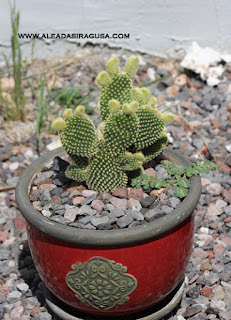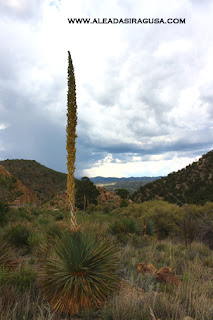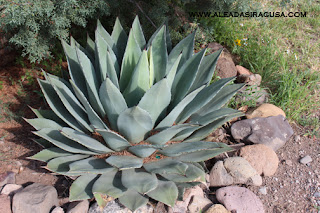Moving
from a semi tropical climate to a high desert semi arid climate has its
adjustments. My husband Guy and I were
not sure we wanted to continue with gardening to the extent we had done in
Florida, but in the five years we have been here we could not resist learning
about the native plants and other compatible arid plants which can be grown
with relative ease, that is to say, drought tolerant and deer resistant.
 |
this large volcanic conglomerate rock
make us easy to find from
La Avenida De San Lorenzo |
 |
Our Solitare Home
Casas Adobes Subdivision
Mimbres New Mexico |
 |
| Steps to garden in frontyard |
The trick
we found in landscaping in this semi arid climate is to frequently water plants for the first two
years, oh and we learned the hard way by not doing this. This year was our
most vigorous planting and gardening so far with more tending and
watering.
 |
| Frontyard Sunflowers |
Sunflowers are a native plant to New Mexico. The wild sunflower has a smaller flower than cultivated sunflowers. We encourage their growth by watering them in the early spring and remove the dead stalks in early winter. The sculpture I created with collected rusted metal, it is in the center of the yard.
 |
| Frontyard Sunflowers and My Rust Sculpture |
We get some fierce torrential rain storms with high wind and hail but often these rains will be short. This summer when the monsoons arrived we had rain almost every day. There is nothing like rain water for the health of the plants; it is like magic.
 |
| Garden plants in backyard |
 |
| Garden plants in frontyard |
 |
Apache Plume Flower |
 |
| Close up of Apache Plume |
 |
| Apache Plume in September |
Our
garden has several varieties of sage, two verities are a blue green color and two are red sages. The red sages are dark green with a red flowers which the humming birds love. Natural plant
nectar I believe is healthier than sugar water for humming birds and other
insects.
 |
| Trident Sage |
 |
Red Sage Bloom
 |
| Sages in backyard |
|
The bird
of paradise and will reseed to form a nice grouping and this plant looks spectacular when it blooms. We have
several in the frontyard and Guy marks new ones with a flag along with the
other plants we are caring for so we can see them for special watering while
they are young.
 |
| Bird of Paradise Bloom |
I bought
a beaver tail from Wal-Mart which is a cactus I learned about from visiting the gardens in
New Mexico State Parks. I like this plant because of its distinct pad pattern
and small size.
 |
| Beaver Tail Cactus |
We were
given some large fish hook barrel cactus from a neighbor who needed to remove
them and we also found some small ones of different variety in our yard.
I am gathering the seed from the barrels along with other seeds to propagate
inside the house in February and then we will plant them in spring after the frost.
 |
| Fish Hook Barrel Cactus in Bloom |
 |
| Fish Hook Barrel Cactus |
 |
| Small Barrel Cactus in Bloom |
In our neighborhood you can see several houses that
have spectacular large Ocotillos and they also grow on the mountainside
just west of us. The Ocotillos are not cacti but they have thorny branches and beautiful red flowers in the spring. We have two small Ocotillos.
 |
Ocotillo
City of Rocks State Park NM |
Our
nearby mountains west of us have many Sotol plants, which are very noticeable
with long bushy spikes in spring though summer, some plants are male and some
female. We bought a couple of sotol plants for the yard from Ace this year
along with several of our other plants. Ace has an excellent native plant
selection in Silver City and the nice thing about the sotol is it does not die
after flowering.
 |
| Common Sotol - Desert Spoon |
This wonderful old Buddleia bush, pictured below, has lilac type flowers which
the humming birds and butterflies just love. I prefer the Buddleia to the Lilac bush
because of the longevity of the bloom and it is also drought tolerant. We recently planted a small Buddleia in our front yard.
 |
| Buddleia - Bloom |
 |
| Buddleia - Butterfly Bush |
Neighbors let us gather pups from their Parry’s Agave, this is a
blue green agave. Now we have a nice grouping of them in the front and
backyard.
 |
| Parry's Agave Pup |
We were
quite smitten with the idea of having an Agave Americana because our frontyard
is very large on our ¾ acre lot.
But after careful consideration we decided
instead on buying seeds to start a few Whales’ Tongue Agave. The Whales’ Tongue
will get as large as the Agave Americana which may reach 3 feet tall by 7 feet
wide.
The Whales Tongue Agave thrives in our high elevation and can handle our cold and occasional wet winters better than the Americana Agave and best of all, it has no pups.
 |
| Parry's Agave |
I do not have a photograph of the Whales Tongue Agave to show you but it is supposed to look like a huge Parry's Agave.
I am
attracted to the blue gray plants because it is contrast to the green and dusky
green Juniper bushes. There is variety when it comes to the desert blue green
plants and I have encouraged these plants to grow in the garden by watering them.
 |
| Thread leaf Groundsel |
 |
| Winterfat, White Sage |
I bought a round sink from Habitat for Humanity Re Store in Silver City to make a lovely bird bath for the birds, bugs and furry critters in our yard
 |
A water source for the critters; a round sink to which
we added a rock in the center so small lizards ect would not drown
and we also placed branches around it for perches |
 |
Sand Aster Flowers - Tohoka Daisy
growing around the birdbath |
Guy was
planning on weed whacking earlier this summer but he decided to wait for the plants to seed and we
are now enjoying watching gold finches eating the seeds from the leggy wild
flowers waving in the wind.
 |
| Goldfinch eating wildflower seeds |
One of
our favorite plants in the yard is the Desert Broom, it looks like a topiary
expert clipped it into perfectly round bushes. In late summer it blooms with
tight little yellow flowers which the birds and insects love. To keep its
lovely shape and manage its size Guy cuts it down before spring.
 |
Desert Brooms in bloom |
 |
| Desert Brooms |
Soon Guy
will start cutting back on the grasses and also when the Datura goes to seed
and starts to die these will also be cut to the ground. Our three Datura, also known
as Moon Flowers are very large; one is about 3 feet tall by 7 feet wide.
 |
| Datura Inoxia - Moon Flowers |
 |
| Moon Flower Bloom |
Guy will weed wack the yard before the grasses dry out too this winter. Gardening
like this is more labor intensive than mowing a yard but it helps with erosion and conserves water. Best of all is the sharing of the bounty the plants provide with the bugs, birds and bunnies and an occasional group
of deer which are frequent visitors to our yard.
Praying Mantis
 |
| Eastern Black Swallowtail Butterfly |
 |
| Cotton Tail Rabbit |
 |
| Visiting Mule Deer |
The beauty of our garden brings us so much joy and as
an artist I have many wonderful subjects for paintings. Plein Air means outdoor paintings from life. Posted below are a few paintings I created; views from my garden.
 |
Barrel in Winter
Plein Air Oil Painting
10" X 8" |
 |
Mountain Wildflowers
Plein Air Oil Painting
6.5" X 7" |
 |
Digging in Garden
Studio Casein Painting
7" X 6.5" |
 |
Thread Leaf Groundsel with Desert Brooms
Plein Air Casein Painting
7" X 6.5"
|
I want to give a special thank you to all our neighbors who generously provided us with plants and cuttings.
Here is an update on my last post Gardening in Southwest New
Mexico.
We bought a backyard Community pool for the neighborhood
birds from Silver City ReStore which supports Habitat for
Humanity. The pool is a big hit with the birds and they visit several times a
day, particularly in the morning, all at once to wash and drink and then fly
away. Now that the birdbaths are freezing in the morning so when Guy gets up he
puts hot water in the birdbaths to thaw the ice. We are enjoying having so many
birds visit our yard and the birds in our yard will make great
subjects for many paintings and drawings.
For many years in Florida I had a large
aviary with small birds in it; which of course Guy built for me. I liked to
spend time with the birds and I did many sketches while visiting with them
after tending to their needs.
Sketching from life keeps an artist quick and
makes one observe the essence of the subject.
Flower Painting in the Wild by James Gurney. I would like to recommend his videos which are informative and enjoyable.
Flower Painting in the Wild Trailer
James Gurney's website and blog has helpful painting information.
Many People probably remember James Gurney best as the creator of Dinotopia. My Millennial Daughter says he is a hero among her friends for his Dinotopia Series because most of them remember growing up loving these books.
Suggested Reading: Common Southwestern Native Plants
by Jack L. Carter, Martha Carter and Donna Stevens
Whales’ Tongue Agave Seeds were bought from Seed Man,
we will plant our seeds in the house in February.
https://www.seedman.com/succulent.htm


























































